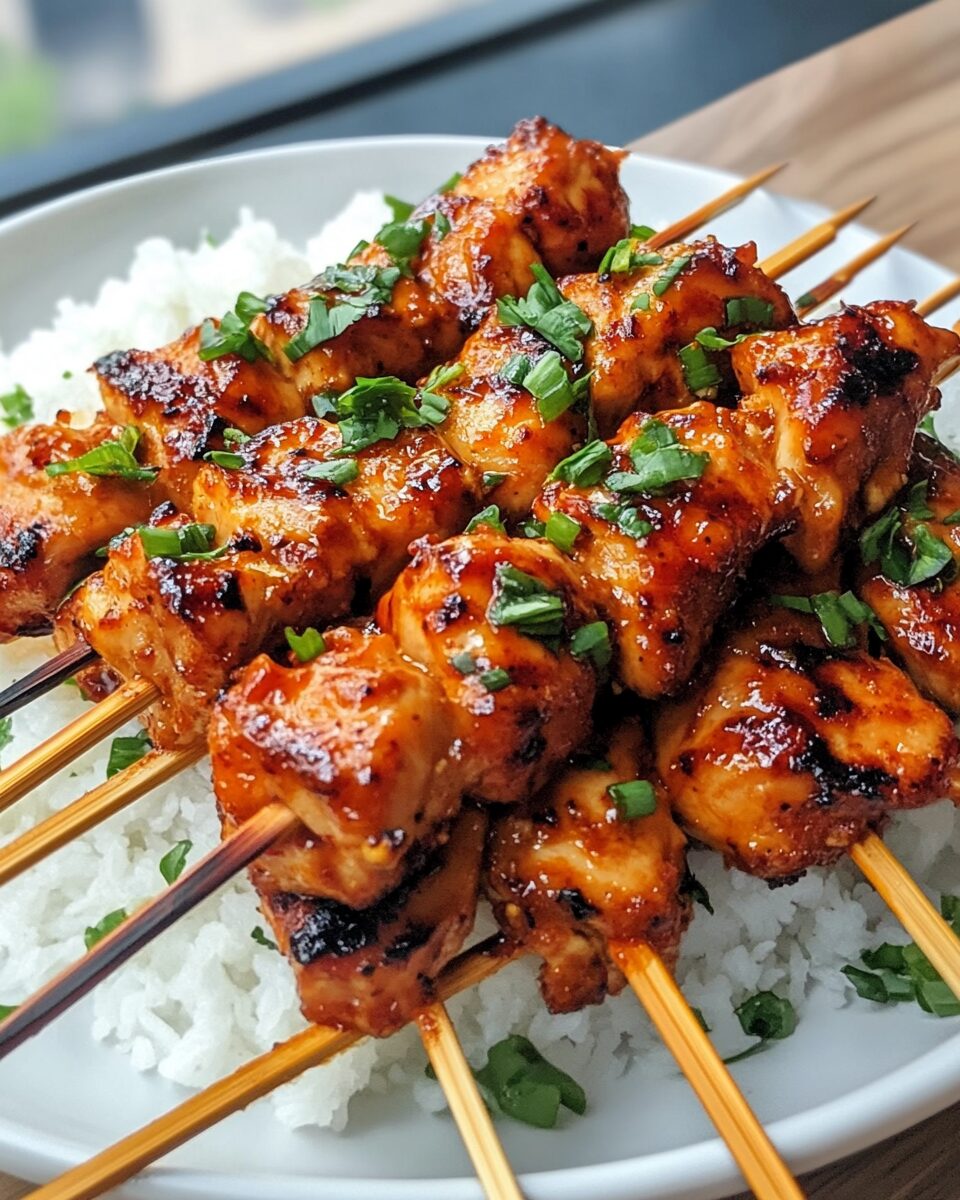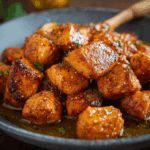The aroma of sweet, spicy, and smoky flavors coming off the grill is enough to make anyone’s mouth water especially when you’re cooking up these Korean Chicken Skewers. Marinated in a bold mix of gochujang, soy sauce, ginger, garlic, and a touch of brown sugar, each bite is packed with flavor and a hint of heat. This dish is ideal for summer grilling sessions or casual weeknight dinners with an Asian twist.
These skewers are not only easy to prepare but also incredibly versatile. Serve them over steamed rice, with grilled vegetables, or alongside a crisp cucumber salad to balance out the heat. Whether you’re hosting a backyard cookout or meal prepping for the week, this recipe brings authentic Korean flavors right to your table in under 30 minutes of cooking time.
Full Recipe:
Ingredients:
-
1½ lbs boneless, skinless chicken thighs
-
2 tsp fresh ginger, finely grated
-
2 tsp garlic, minced
-
3 tbsp low sodium soy sauce
-
3 tbsp brown sugar (light or dark)
-
1 tsp sesame oil
-
1 tbsp rice vinegar
-
2 tbsp gochujang (Korean chili paste)
-
Chopped green onions (optional, for garnish)
-
Skewers (metal or soaked wooden)
Directions:
-
Cut chicken into 1½-inch cubes and place in a large bowl.
-
In a small bowl, whisk together the ginger, garlic, soy sauce, brown sugar, sesame oil, vinegar, and gochujang.
-
Pour half of the marinade over the chicken. Toss to coat evenly.
-
Cover and marinate in the fridge for at least 4 hours or overnight. Reserve the remaining marinade for basting.
-
Preheat grill to medium heat.
-
Thread marinated chicken pieces onto skewers.
-
Grill the skewers, turning every 3–4 minutes for a total of 20–30 minutes, or until internal temperature reaches 165°F.
-
Baste with remaining marinade during the last few minutes of grilling.
-
Remove from grill and garnish with green onions if desired. Serve with rice or fresh salad.
Prep Time: 4 hours | Cooking Time: 30 minutes | Total Time: 4 hours 30 minutes
Kcal: 264 kcal | Servings: 4 servings
Korean Chicken Skewers: A Perfect Balance of Bold Flavor and Grilling Tradition
When it comes to flavorful, crowd-pleasing dishes that shine at backyard barbecues and weeknight dinners alike, few recipes match the irresistible appeal of Korean Chicken Skewers. This dish blends Korea’s rich culinary heritage with the universal love of grilled meats on a stick. Spicy, savory, and just a little sweet, these skewers are coated in a dynamic gochujang-based marinade that locks in flavor and guarantees a juicy finish on the grill.
Whether you’re a fan of Korean cuisine or simply love exploring new and exciting flavors, Korean Chicken Skewers offer a beautiful balance of convenience and gourmet flair. Perfectly charred on the outside and juicy on the inside, they are easy to customize and even easier to devour.
A Glimpse Into Korean Grilling Traditions
Grilled meat has a special place in Korean food culture, where the act of barbecuing is as much about community as it is about taste. While most people associate Korean BBQ with tabletop grilling at restaurants, home-cooked grilled dishes like these skewers also play an important role in everyday meals.
Koreans often enjoy meats like dak-galbi (spicy stir-fried chicken) and bulgogi (marinated beef), but skewered options such as these chicken skewers marinated with fermented chili paste and grilled to caramelized perfection capture the same spirit of fire and flavor. They’re great for parties, quick family meals, or even meal prepping for the week.
The Flavor That Starts With Gochujang
At the heart of the recipe is gochujang, Korea’s iconic fermented chili paste. Thick, spicy, slightly sweet, and deeply umami-rich, gochujang offers more than just heat. It’s a complex condiment that transforms even the simplest ingredients into something extraordinary.
The fermentation process gives gochujang a richness and depth that’s hard to replicate with standard chili sauces. In this recipe, it’s combined with soy sauce, sesame oil, brown sugar, ginger, and garlic to form a marinade that’s layered with tang, spice, and a touch of sweetness.
The longer the chicken marinates, the better it absorbs all those bold Korean flavors, making each bite succulent and full of personality.
Why Chicken Thighs Work Best
While you can certainly use chicken breast, boneless, skinless chicken thighs are preferred for this dish and for good reason. Thighs have a higher fat content, which means they stay juicy even when grilled over high heat. They also absorb the marinade more effectively, giving you a fuller, richer flavor.
The cut of the chicken matters not just for texture, but also for how well it holds up on the grill. Thighs remain tender and flavorful even if slightly overcooked, making them more forgiving and ideal for outdoor cooking or even stove-top grilling.
The Magic of the Grill
Grilling adds another layer of deliciousness to this already well-seasoned dish. The heat caramelizes the sugar in the marinade, creating crispy edges and that beloved smoky char. This combination of spicy-sweet flavor with charred, juicy meat is where Korean Chicken Skewers truly shine.
Using skewers allows for even cooking and easy handling, whether you’re grilling outdoors or on a stovetop grill pan. Each turn of the skewer adds more dimension, with caramelized bits clinging to the edges and tender centers soaking in any remaining basting sauce.
Serving Suggestions
The beauty of Korean Chicken Skewers is how well they fit into a wide variety of meals. They’re hearty enough to stand on their own, but pair beautifully with both traditional and modern sides:
-
Steamed white rice or brown rice for a classic Korean-style plate
-
Kimchi or pickled cucumbers for a bright, tangy contrast
-
Grilled zucchini or mushrooms for a healthy BBQ combo
-
Asian slaw with sesame dressing for added crunch
-
Rice noodles or glass noodles as a cool side option
-
Lettuce wraps with fresh herbs, perfect for hands-on eating
You can also cube leftovers and toss them into fried rice or use them in sandwiches, rice bowls, or salads.
Substitutions and Variations
Don’t have gochujang on hand? While it’s the star of the show, you can create a makeshift alternative by mixing tomato paste with a bit of sriracha or chili garlic sauce and a touch of sugar. It won’t be quite the same, but it can still bring that sweet-heat balance.
For those sensitive to heat, reduce the amount of gochujang or add extra sugar or honey to mellow things out. Want to go gluten-free? Use tamari instead of soy sauce, and always check labels on your gochujang brand.
You can also adapt this recipe by swapping chicken for pork shoulder, beef sirloin, or even tofu or tempeh for a plant-based version. The marinade works on a variety of proteins and can be used as a glaze or dip as well.
Nutritional Snapshot
This dish is surprisingly balanced. With around 264 calories per serving, it provides a healthy dose of protein over 30g per portion and moderate carbs and fats. The sugar is mostly from natural brown sugar and gochujang, but it’s used in controlled amounts to balance the savory heat.
Grilled rather than fried, these skewers also skip the heaviness of oil-heavy cooking methods, making them a great option for those looking to eat well without sacrificing flavor.
Cultural Significance of Skewers in Asian Cuisine
Skewered foods are common across many Asian cultures. From Japanese yakitori to Middle Eastern kebabs, food on sticks is universal in its appeal. In Korean culture, skewers like dakkochi (spicy chicken skewers) are popular street foods, often grilled right in front of you and brushed with sweet and spicy sauces as they cook.
This recipe captures that same essence: simple ingredients elevated by technique and seasoning, offering a dish that’s both approachable and exciting. It’s fusion-friendly, globally inspired, and 100% crave-worthy.
A Dish That Brings People Together
Whether you’re cooking for your family or hosting a casual get-together, Korean Chicken Skewers are guaranteed to be a hit. They’re easy to scale up, prep ahead of time, and cook quickly all while delivering a powerful punch of flavor. Their interactive nature also encourages communal dining, as people can grab a skewer and build their own plate.
Pair them with a cold beer or a sparkling non-alcoholic drink, and you’ve got yourself a summer meal worth remembering.
Conclusion:
Korean Chicken Skewers are far more than a convenient BBQ option they’re a celebration of flavor, balance, and technique. With their savory-spicy profile, charred perfection, and versatile serving possibilities, they offer a snapshot of Korean-inspired cooking at its most fun and flavorful.
For home cooks wanting to explore bold new tastes without complicated steps, this dish is a gateway into Korean cuisine. Gochujang may be the first new pantry staple you fall in love with, and once you see how easy it is to make something this delicious, you’ll want to keep experimenting.
In a world where recipes can sometimes feel too complex or intimidating, this one stands out for its simplicity, adaptability, and satisfying results. Add it to your recipe rotation you’ll be glad you did.






